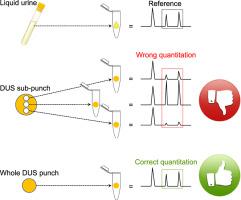Analytica Chimica Acta ( IF 5.7 ) Pub Date : 2023-03-11 , DOI: 10.1016/j.aca.2023.341071 Miloš Dvořák 1 , Richard Maršala 2 , Pavel Kubáň 1

|
Analysis of dried urine spots (DUSs) is becoming an emerging technique in clinical, toxicological, and forensic chemistry due to the fully non-invasive collection, facile transportation, and simple storage of DUS samples. Correct DUS collection and elution is of the utmost importance because inadequate DUS sampling/processing may have direct consequences on quantitative DUS analyses and these aspects were, for the first time, comprehensively investigated in this contribution. Various groups of endogenous and exogenous species were selected as model analytes and their concentrations were monitored in DUSs collected on standard cellulose-based sampling cards. Strong chromatographic effects were observed for most analytes having a crucial impact on their distribution within the DUSs during sampling. Concentrations of target analytes were up to 3.75-fold higher in the central DUS sub-punch in comparison to the liquid urine. Consequently, substantially reduced concentrations of these analytes were determined in peripheral DUS sub-punches demonstrating that sub-punching, often applied to dried material spots, is not acceptable for quantitative DUS analyses. Hence, a simple, rapid, and user-friendly procedure was suggested, which employed an in-vial collection of a known urine volume on a pre-punched sampling disc (using a low-cost micropipette designed for patient-centric clinical sampling) and in-vial processing of the whole DUS. Excellent accuracy (0.20%) and precision (0.89%) of liquid transfers were achieved by the micropipette, which was also applied to remote DUS collection by laic and expert users. The resulting DUS eluates were analysed by capillary electrophoresis (CE) for the determination of endogenous urine species. The CE results demonstrated no significant differences between the two user groups, elution efficiencies of 88–100% (in comparison to the liquid urine), and precision better than 5.5%.
中文翻译:

用于定量分析的瓶内干燥尿液点采集和处理
由于 DUS 样品完全无创采集、运输方便和储存简单,干尿斑 (DUS) 分析正成为临床、毒理学和法医化学中的一项新兴技术。正确的 DUS 收集和洗脱是最重要的,因为 DUS 采样/处理不充分可能对定量 DUS 分析产生直接影响,并且这些方面是第一次在这篇文章中进行全面调查。选择各种组的内源性和外源性物种作为模型分析物,并在标准纤维素采样卡上收集的 DUS 中监测它们的浓度。大多数分析物都观察到强烈的色谱效应,这些分析物在采样过程中对其在 DUS 内的分布具有至关重要的影响。目标分析物的浓度高达 3。与液体尿液相比,中央 DUS 子孔中的浓度高 75 倍。因此,在外围 DUS 子冲孔中确定这些分析物的浓度大大降低,这表明通常应用于干燥材料点的子冲孔对于定量 DUS 分析是不可接受的。因此,提出了一种简单、快速且用户友好的程序,该程序采用在预先打孔的采样盘上收集已知尿液量的小瓶(使用专为以患者为中心的临床采样而设计的低成本微量移液器)和整个 DUS 的小瓶内处理。微量移液器实现了出色的液体转移准确度 (0.20%) 和精密度 (0.89%),外行和专家用户也将其应用于远程 DUS 收集。通过毛细管电泳 (CE) 分析产生的 DUS 洗脱液,以确定内源性尿液种类。CE 结果表明两个用户组之间没有显着差异,洗脱效率为 88-100%(与液体尿液相比),精度优于 5.5%。











































 京公网安备 11010802027423号
京公网安备 11010802027423号